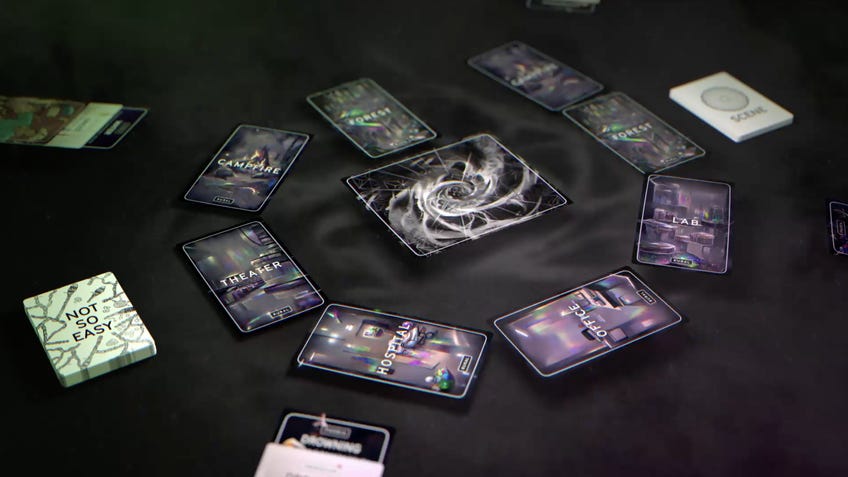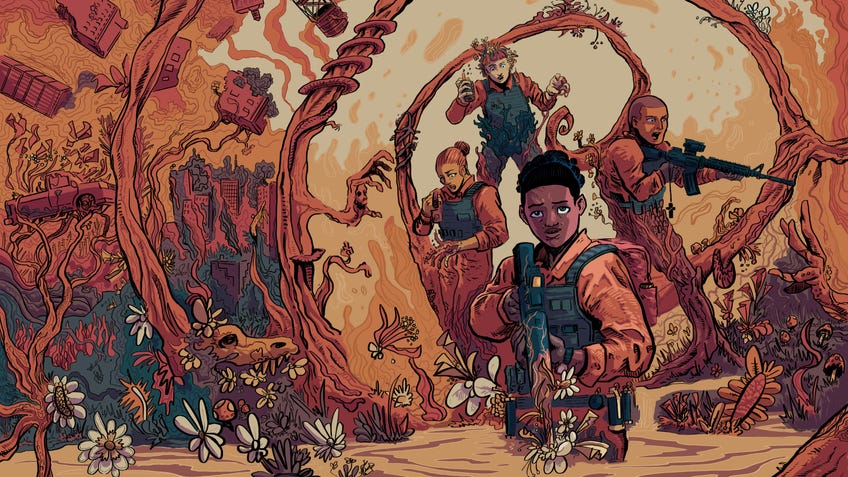How new tabletop RPG The Zone embraced, and then kicked, AI-generated art
Journeys of self-destruction.
It was his third time watching Annihilation that finally broke Raph D’Amico open.
The designer of new tabletop RPG The Zone, which is currently crowdfunding on Kickstarter, had just ended a major relationship and was struggling with a stressful job. Something about Alex Garland’s 2018 adaptation of the Jeff VanderMeer novel “got under [his] skin” and germinated into a prototype game about taking obsessions and psychoses into an inhuman place that reflected the dark contours of humanity back at player characters.
In 2019, the UX designer-by-day faced a health crisis that ground life to a halt. Instead of showing the prototype of what would become The Zone at conventions, he spent the rest of the year restructuring life around chronic pain and a homebound existence that pre-dated (but admittedly prepared him for) the COVID-19 pandemic. In fact, he spent most of that year preparing physical versions for a March 2020 playtest period that never happened.
I realised that on an artistic level, the themes I'm using the AI to explore just don't come through anymore because all people are likely to see is ‘It's AI art’.
After a year of unsuccessful surgeries, injections, therapy and prescription medication, D’Amico tried psychedelic therapy and “came very close to the ego death”. That process of healing from intense burnout and coping with chronic pain led to a design epiphany about confronting destructive patterns, saying “the game was talking to me the whole time”.
In the midst of a hellacious California wildfire season that birthed the “red sky” phenomenon, he ported the prototype to Story Synth. (“Finally, the production design of the world matches the story.”) The playtesting platform allowed D’Amico to host The Zone for free and garnered over 300 feedback sessions. He plans to keep the digital version open without cost, calling it his version of Itch.io’s community copies, and will continue to finesse accessibility features - screen reader support is reportedly on its way.
The Zone keeps its focus on the exploration of each player’s character as they gradually explore the titular alien landscape that, card by card, reflects their deeply held insecurities, fears and dark passions in a twisted mirror of organic mutations. Each character is defined by a phobia and an obsession, and the group spends the first half of the game in a no-lose period of discovery and interrogation.
“I’m making a pact with the players that says, much like a kind of therapy session, ‘You can go in and explore the most dangerous stuff imaginable, and you're going to be fine,’” D’Amico says.
The more creativity you unleash into the world by giving better tools to everyone, I think that's a good thing. But you need to have a society that is structured around proper support systems.
After a turn that, like the rest of the game, is communicated through a deck of facilitator cards that help offload the cognitive work of running a session, things begin to get extremely weird. Players will face their predetermined fate with quiet acceptance or screaming indignation, but everyone is encouraged to do so in the dark with glow sticks providing extremely creepy mood lighting - the cards and other implements have been designed to work well in such an environment.
The Zone itself undulates between three possible descriptive modes - sublime, spooky and grotesque - and becomes controlled by players after they perish inside. Only one player will make it to The Center, and everyone else who has perished collaboratively decides their final fate, whether that’s evisceration by a plant werewolf or a slow dissolution by way of radiation.

When D’Amico first spoke to Dicebreaker in mid-August, he expressed a tentative excitement with the prospect of using AI-generated art from the Disco Diffusion algorithm for cards that depicted The Zone. The thematic resonance felt all-too-apparent; like The Zone, AI art bots take pieces of humanity and regurgitate something smudgy, uncanny and off-putting back at us. Everything else in the game used illustrations from contracted artists who retained copyright on their work.
AI-generated art has become a hot topic within the tabletop industry, following similar discussions in nearly every creative field suddenly facing the possibility of a future where powerful algorithms fall into the hands of large corporations or Silicon Valley tech bros with money to burn and no ethical underpinning.
I’m making a pact with the players that says, much like a kind of therapy session, ‘You can go in and explore the most dangerous stuff imaginable, and you're going to be fine.'
Detractors argue the uptake of AI art shouldn’t progress until some baseline assumptions have been folded into their structure. Namely, artists whose work is scraped into the millions and billions of images used to train these models should be able to both opt out of such inclusion and also be compensated when it happens. If that practice feels impractical, critics argue it simply lays bare the ugly truths of art commodification in a capitalist system. These algorithms are just the latest window into that particular hell.
D’Amico believed there was a path forward that didn’t extort or endanger his peers. “If I'm Wizards of the Coast, I can afford to commission 100 cards’ worth of art,” he said at the time. “But also, there's restrictions: I don't feel comfortable using prompts that have the name of an artist. I'm using open-source versions of this stuff. I'm not using any of the commercial products, and I'll release the notebook.
“The more creativity you unleash into the world by giving better tools to everyone, I think that's a good thing. But you need to have a society that is structured around proper support systems, like unions and funding of the arts, to make sure that people don't get totally screwed over by it.”
Two weeks later, as the launch of The Zone’s Kickstarter neared, D’Amico emailed Dicebreaker and announced that he had removed the AI-generated art from his game. “The short version is that I still feel that same tension I shared with you: I want the magic these tools bring because it allows everyone to be more creative - this is why I make RPGs!” he wrote. “But I want just as badly for them to be done in a way that isn't exploitative (and to live in a non-exploitative society more broadly).
“On an ethical level, the personal code of conduct just didn't feel like enough right now to address the fundamental issue of how the images were sourced. That was enough, but I also realised that on an artistic level, the themes I'm using the AI to explore just don't come through anymore because all people are likely to see is ‘It's AI art’.”
The version of The Zone being sold through crowdfunding contains original illustrations by Erik Whalen, Caitlin Russell, Veronique Meignaud and Erica Williams. Physical editions of the game are expected to ship to backers in May 2023, while the digital version will remain free in perpetuity.
“I'm not an AI art hater,” D’Amico added. “I still think it's a brilliant new medium for exploration, concept art, fun personal use and pure artistic experiments. And it is just incredible for horror! But the only case right now where it feels right to use it in something people can pay for is art about AI art. The Zone is not that!”



